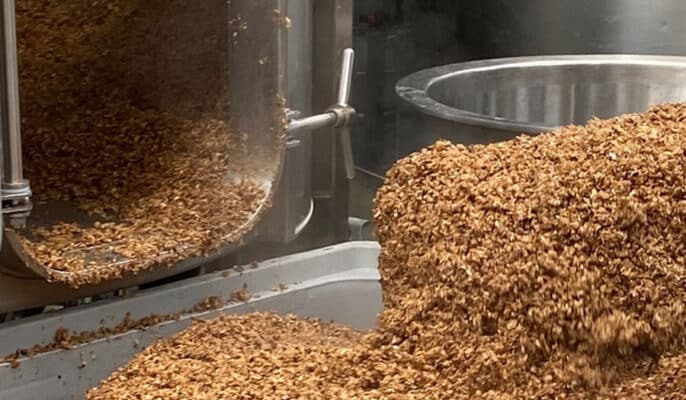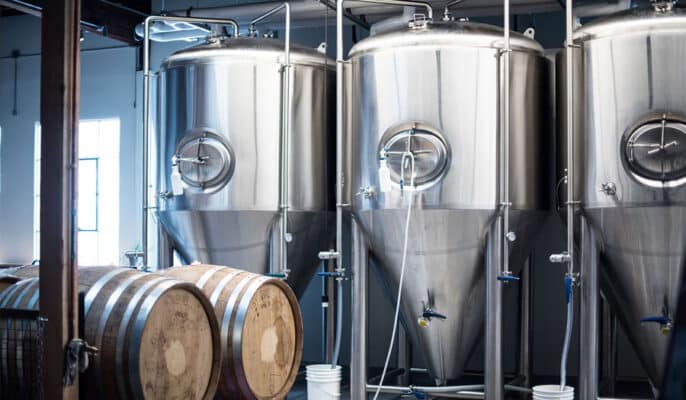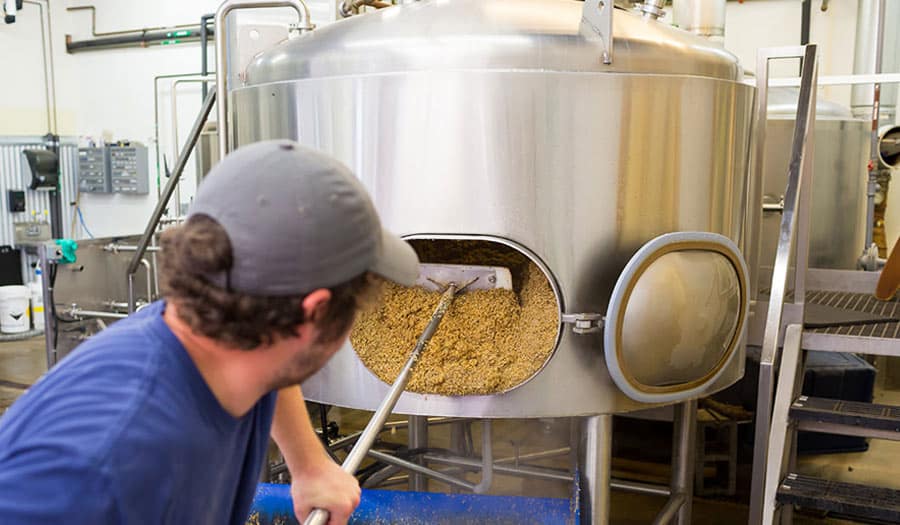In the process of beer brewing and production, the selection and configuration of beer brewing equipment is crucial. Breweries need a series of specialized brewing equipment to complete every link from raw material processing to final product packaging. Each piece of equipment plays a unique role in the production process, from malting, mash, boiling, and fermentation to maturation and packaging, each step is inseparable from the support of efficient and reliable brewing equipment.
Beer production process
- Most beers are brewed from four basic ingredients: grains, water, hops, and yeast. The premise of brewing is to extract sugar from grains, which yeast then converts into alcohol through a fermentation process.
- Raw material preparation: Grains such as barley are soaked, germinated, and dried to form malt. The malt is ground into coarse powder and prepared for mash.
- Mash: Malt powder is mixed with hot water, heated, and stirred to convert starch into fermentable sugars. The malt residue and saccharified wort are separated.
- Boiling: The wort is heated to boiling point, and spices such as hops are added and boiled to extract bitterness and aroma. The boiled wort is quickly cooled to a suitable fermentation temperature.
- Fermentation: The cooled wort is mixed with yeast for primary fermentation, and the yeast converts sugar into alcohol and carbon dioxide.
- Maturation: The beer is further stored and matured after fermentation to develop flavor and stabilize taste.

Matériel de brassage
Malters
Grinding the grains you choose for beer is the first step in brewing beer. A malt machine is a piece of equipment that can crush large quantities of grain at once. The process involves steeping, germinating, and drying. The choice of malt machine will affect the flavor and quality of the final beer.
Considering the huge amount of grain you may be working with, you need a reliable piece of equipment so that it can last a long time and be used for many batches.
Bouilloire
The brew kettle, also known as the mash kettle or mash pot, is one of the most crucial pieces of equipment in beer production. Its main function is to mix the crushed malt with hot water for the mashing process. During this process, the starch in the malt is converted into fermentable sugars, providing the necessary raw materials for the subsequent fermentation stage.
The brew kettle is usually made of stainless steel or other corrosion-resistant materials with good thermal conductivity and durability. It is equipped with a heating system (such as steam heating or electric heating) to maintain the required temperature and a stirring device to ensure the uniform mixing of malt and water. Modern brew kettles may also be equipped with a temperature control system and an automated control panel to accurately adjust and monitor the temperature and time during the mashing process to ensure conversion efficiency and beer flavor consistency.
Équipement d'ébullition
The boiling equipment is a key part of beer production, used to heat the mashed wort to boiling point, where you can add the all-important hops. It is in this boiling pot that you will begin to develop the final flavor of the beer. The heat and time in the boiling pot will also affect the color and smell of the beer. Many boiling pots have vortex systems that help remove solid particles from the liquid throughout the process and eliminate possible microorganisms through high temperatures, ensuring the safety and stability of the beer.
Cuve de fermentation
The fermentation tank is one of the most critical equipment in beer production. It is used to mix the cooled wort with yeast for fermentation. The design of the fermentation tank affects the activity of the yeast and the flavor of the beer. Once you have brewed your beer and added the basic ingredients, the next step is to move it into the fermentation tank, sometimes called a single tank, depending on the style of beer. Commercial brewing requires quite a few fermentation tanks, and the fermentation tanks need to be larger to accommodate the beer you want to produce. Here, you can add yeast to transform the wort into real beer. Fermentation tanks are strictly controlled environments that help yeast convert sugars into alcohol.
Réservoir lumineux
A bright Tank, also known as a maturation tank or post-fermentation tank, is an important equipment used in beer production for the final maturation and stabilization of beer. It is mainly used for further maturation, clarification, and carbonation processes after the fermentation of beer is completed. The design and function of the bright tank play a key role in the final quality, flavor, and appearance of the beer. Bright tanks are usually made of high-quality stainless steel to ensure corrosion resistance and durability. Stainless steel is also easy to clean and disinfect, ensuring that the quality of beer is not contaminated. The shape of bright tanks is mostly cylindrical to facilitate the separation of sediments and uniform gas distribution. The size varies according to the scale of production, ranging from small experimental tanks to large industrial-grade tanks.
Équipement de remplissage
Kegs and bottling lines are essential for packaging and distributing the final product. They ensure that the beer is delivered to consumers in the freshest state while improving production efficiency. The beer is accurately poured into the container, usually including an automated control system to adjust the filling volume and speed. The container is capped to ensure that the beer is not contaminated by the outside world and maintains its freshness. The closing process can include bottle cap closure, can sealing, etc. For filling beer into cans with efficient filling and capping systems for large-scale production.
Comment choisir son matériel de brassage de bière ?
Brewing scale
- Home brewing: If you are a home brewer, the equipment should be suitable for the batch size you need. Small brewing equipment is usually suitable for beginners, with a capacity ranging from a few liters to tens of liters.
- Commercial brewing: If you plan to brew commercially, the equipment needs to have a larger output, and you may need a system ranging from tens of liters to hundreds of liters.
Brewing equipment type
- Fully automatic vs. semi-automatic: Fully automatic equipment is suitable for people who like to simplify the process. They can automatically control temperature, stirring, etc. However, they are usually more expensive. Semi-automatic equipment requires more manual intervention but is usually more affordable.
- Batch brewing vs. continuous brewing: Batch brewing is suitable for small-scale brewing and diversified products. Continuous brewing is suitable for large-scale production and can improve production efficiency.
Budget financier
- Entry-level: For brewers who are just starting, consider an affordable kit that may include a basic boiler, fermentation tank, and temperature control device.
- Advanced: If you have a higher budget, you can invest in more advanced equipment, such as stainless steel fermentation tanks, automation systems, etc.
Brewing Equipment Materials
- Stainless steel: Durable and easy to clean, it is the preferred material for most brewing equipment.
- Aluminum: Usually lighter, but may not be as durable as stainless steel.
- Glass: Suitable for small-scale experiments, but not suitable for large-scale production.
Caractéristiques supplémentaires
- Temperature Control System: Accurate temperature control is very important for the brewing process, especially for yeast fermentation.
- Agitator: Some equipment is equipped with an automatic stirring function, which can improve the mixing effect.
- Filtration System: Helps remove impurities and improve the quality of beer.
Service après-vente
Learn about the warranty and repair services provided by the supplier to ensure that you can get timely help when there is a problem with the equipment.
The Importance of High-Quality Beer Brewing Equipment
efficiency and productivity
Quality brewing equipment not only improves the quality of your beer but also significantly improves the overall efficiency of the brewing process. Advanced systems simplify everything from pounding and boiling to fermentation and packaging, reducing the risk of production errors and reducing downtime, making high-volume production more feasible. This efficiency helps commercial breweries maintain excellent standards while meeting high demand.
Durabilité et longévité
Investing in high-quality brewing equipment is a smart long-term choice, as they are often extremely durable. Top-of-the-line equipment uses rugged materials such as corrosion-resistant and wear-resistant stainless steel to withstand heavy use. Maintenance requirements and replacement frequency are reduced, resulting in significant cost savings and a higher return on investment for brewers.
Améliorer la saveur et l'arôme
Brewing equipment has a direct impact on the flavor and aroma of the final product. High-quality equipment allows for more precise control of the brewing environment. For example, a yeast fermenter equipped with precise temperature control can keep the yeast in optimal condition and help achieve the desired fermentation characteristics. At the same time, these devices can effectively prevent contamination and odor, making the beer taste purer and more refined.
Consistency and quality control
One of the most significant advantages of high-quality beer brewing equipment is its ability to ensure the consistency of each batch of beer. Precisely controlled brew pots, fermenters, and filtration systems ensure consistency of specific temperatures and conditions. This precise control is critical to maintaining the taste, aroma, and overall quality of your beer, thereby increasing customer satisfaction and brand reputation.

FAQ
What basic beer brewing equipment is needed?
- Brew pot: used to heat malt and water.
- Fermentation tank: a container used for fermentation, usually equipped with an airlock.
- Cooler: used to quickly cool the boiled wort.
- Filter: used to remove malt residue.
- Temperature controller: ensures that the yeast ferments at the optimal temperature.
- Bottling equipment or keg equipment: used to bottle or keg the finished beer.
What specifications do brew pots need?
The size of the brew pot depends on the batch you plan to brew. Home brewing usually uses a pot with a capacity of 10-50 liters, while commercial production may require a larger pot.
How to ensure the quality and consistency of beer?
- Cleaning and disinfection: All equipment must be thoroughly cleaned and disinfected before and after use to avoid infection and contamination.
- Temperature control: Maintaining a stable fermentation temperature is essential for consistency. Investing in good temperature control equipment can help maintain the consistency of each batch of beer.
- Recording and tracking: Recording the parameters and process of each brewing helps with analysis and improvement.
How long is the life of brewing equipment usually?
- Home brewing equipment: Generally, well-maintained home brewing equipment can last for many years.
- Commercial equipment: Commercial brewing equipment is usually designed to be more rugged can withstand frequent use and has a longer lifespan, but it still requires regular maintenance to maintain optimal performance.




